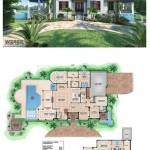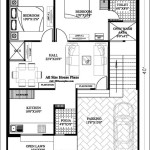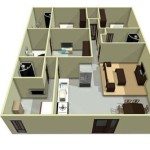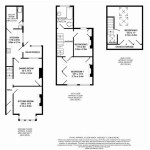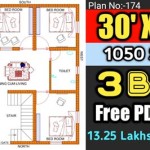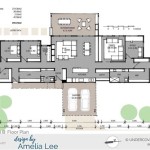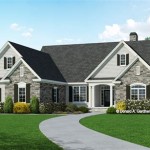Floor Plan of a Two-Story House: A Comprehensive Guide
The floor plan of a two-story house represents a blueprint for its spatial organization, encompassing the layout of rooms, hallways, staircases, and other key architectural elements across both levels. Understanding this plan is crucial for prospective homeowners, builders, and interior designers alike, as it dictates functionality, flow, and overall livability. A well-designed two-story house plan optimizes space utilization and caters to the specific needs and lifestyle of its inhabitants.
Developing or interpreting a two-story house floor plan involves several key considerations, ranging from basic dimensions to the placement of utilities and adherence to building codes. The process typically begins with understanding the site's constraints and opportunities, including its size, orientation, and any existing features. Factors like sunlight exposure, prevailing winds, and proximity to neighboring properties can significantly influence the placement of rooms and the overall design.
This article delves into the various aspects of a two-story house floor plan, providing a comprehensive overview of its components, design principles, and considerations for optimal space utilization and functionality.
Key Considerations for Designing a Two-Story Floor Plan
Designing a two-story house floor plan is a complex undertaking that requires careful consideration of several factors. The choices made during the planning phase will directly impact the comfort, functionality, and long-term value of the home. Therefore, it is crucial to approach the design process with a clear understanding of the homeowner's needs, budget constraints, and local building regulations.
Firstly, the intended use of each room must be carefully considered. For example, the kitchen should be located in an area that allows for easy access to the dining room and pantry. Bedrooms should be positioned in quieter areas of the house, away from the main living spaces and street noise. The number of bedrooms and bathrooms needed will depend on the size of the family and their lifestyle. In addition, it is important to consider the need for specialized spaces, such as a home office, exercise room, or media room.
Secondly, the layout of the floor plan should promote a natural flow between rooms. This means avoiding awkward transitions or bottlenecks that can make the house feel cramped or disorganized. The staircase should be centrally located and easily accessible from both floors. Hallways should be wide enough to accommodate furniture and foot traffic. The overall goal is to create a sense of spaciousness and ease of movement throughout the house.
Thirdly, energy efficiency should be a primary concern in the design process. This includes maximizing natural light and ventilation, selecting energy-efficient windows and insulation, and orienting the house to take advantage of solar gains in the winter and minimize heat gain in the summer. The placement of windows and doors should be carefully considered to minimize drafts and maximize energy savings. Additionally, the use of sustainable building materials can further reduce the environmental impact of the house.
Finally, the design should comply with all applicable building codes and regulations. This includes requirements for fire safety, accessibility, and structural integrity. It is important to consult with a qualified architect or builder to ensure that the design meets all necessary standards. Failure to comply with building codes can result in costly delays and modifications during construction.
Understanding the Components of a Two-Story Floor Plan
A two-story house floor plan is comprised of various distinct components, each serving a specific purpose and contributing to the overall functionality of the dwelling. These components can be broadly categorized into living areas, sleeping areas, service areas, and circulation spaces. A clear understanding of these components and their interrelationships is essential for effective floor plan design.
Living Areas: These typically encompass the ground floor and include spaces such as the living room, family room, dining room, and kitchen. The living room serves as a primary gathering space for relaxation and entertainment. The family room provides a more casual and informal setting for family activities. The dining room is dedicated to meals and gatherings. The kitchen, often considered the heart of the home, is where food preparation and cooking take place. Open-concept designs often integrate the kitchen, dining, and living areas to create a more spacious and connected living environment.
Sleeping Areas: These are generally located on the upper floor, offering privacy and quiet for rest. Bedrooms, bathrooms, and walk-in closets are the primary components of the sleeping area. The master bedroom, typically larger than other bedrooms, often includes an ensuite bathroom and walk-in closet. Guest bedrooms provide accommodations for visitors. Bathrooms are equipped with essential fixtures, such as toilets, sinks, and showers or bathtubs. Proper ventilation and lighting are crucial in these areas.
Service Areas: These areas support the functional aspects of the house and include spaces such as the garage, laundry room, mudroom, and storage areas. The garage provides parking for vehicles and storage for tools and equipment. The laundry room is dedicated to washing and drying clothes. The mudroom serves as a transitional space between the outdoors and the indoors, providing a place to remove shoes and outerwear. Storage areas, such as closets and pantries, are essential for organizing and storing household items.
Circulation Spaces: These areas facilitate movement between different parts of the house and include hallways, staircases, and entryways. Hallways connect rooms and provide access to different areas of the house. Staircases provide vertical access between the two floors. Entryways serve as the main point of entry into the house, providing a welcoming and functional space for greeting guests and entering the home. The design of circulation spaces should prioritize ease of movement and accessibility.
The effective integration of these components is crucial for creating a functional and comfortable two-story house. Careful consideration should be given to the placement of each component relative to the others, ensuring that they complement each other and contribute to the overall flow of the house.
Optimizing Space Utilization in a Two-Story House
Optimizing space utilization in a two-story house involves maximizing the functionality and efficiency of every square foot. With a two-story design, there is inherent potential for efficient space allocation, but careful planning is crucial to avoid wasted areas and awkward layouts. Several strategies can be employed to achieve optimal space utilization, ranging from creative storage solutions to the strategic placement of rooms and features.
Vertical Space: Utilizing vertical space is paramount in a two-story house. High ceilings can create a sense of spaciousness and allow for the incorporation of features such as lofts or mezzanine levels. Strategic placement of windows can maximize natural light and create a more open and airy atmosphere. In areas with lower ceilings, such as basements or attics, creative storage solutions can be implemented to maximize usable space. Built-in shelving, cabinets, and drawers can be used to organize and store items efficiently.
Open-Concept Design: Combining living areas, such as the kitchen, dining room, and living room, into a single open space can create a more spacious and connected environment. This design approach eliminates the need for dividing walls, allowing for a better flow of natural light and ventilation. Open-concept designs are particularly well-suited for families who enjoy spending time together and entertaining guests.
Multi-Functional Spaces: Designing rooms that can serve multiple purposes is another effective way to optimize space utilization. For example, a guest bedroom can be designed to double as a home office or exercise room. A living room can be designed to accommodate a home theater or library. Incorporating flexible furniture, such as sofa beds and convertible tables, can further enhance the versatility of multi-functional spaces.
Storage Solutions: Incorporating ample storage space is essential for maintaining a clutter-free and organized home. Built-in storage solutions, such as closets, cabinets, and drawers, can be integrated into the design to maximize storage capacity. Under-stair storage, attic storage, and basement storage can provide additional space for storing seasonal items and infrequently used belongings. Proper organization and labeling of storage areas can further enhance their functionality.
Efficient Layout Design: A well-designed layout can significantly improve space utilization. Minimizing hallway space and avoiding awkward angles can prevent wasted square footage. Strategically placing rooms and features can create a more efficient and functional flow. For example, placing the laundry room near the bedrooms can make it easier to manage laundry tasks. Placing the kitchen near the dining room can facilitate meal preparation and serving.
By implementing these strategies, homeowners can maximize the functionality and efficiency of their two-story house, creating a comfortable and livable space that meets their specific needs and preferences.

2 Y House Plans Floor Plan With Perspective New Nor Two Story Blueprints Cape

Custom 2 Story Houses New Two Home Plans Housing Development D House Layout Sims Layouts

Unique Two Story House Plan Floor Plans For Large 2 Homes Desi Family Blueprints Victorian

Casa Amplia Two Story House Plans Blueprints Cape

Unique Two Story House Plan Floor Plans For Large 2 Homes Desi

Minecraft 2 Story House Blueprints Google Search Plans Y New Two

2 Story House Plans For Narrow Lots Blog Builderhouseplans Com

2 Story House Plans Blog Dreamhomesource Com

2 Story House Plans Small Mansion Farmhouse Modern More Blog Floorplans Com

Modern Two Story House Design 4 Bedroom Floor Plan Nethouseplans

